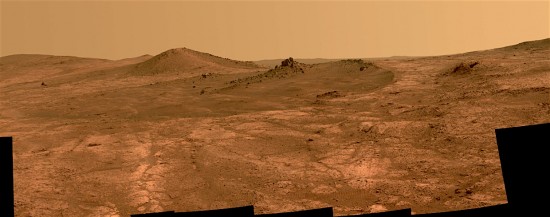
Image from March 2015 shows a rock spire in a shallow crater called Spirit of St. Louis. Credit: NASA/JPL-Caltech/Cornell Univ./Arizona State University
Jan 29, 2016
The Opportunity rover marks twelve years on Mars.
The Mars Exploration Rover (MER) Opportunity bounced to a landing in Meridiani Planum on Sunday, January 5, 2004 after spending six months in flight. Opportunity was scheduled to spend six months in the frozen desert of Mars, but its data collection compelled NASA managers to continue the mission indefinitely.
Opportunity was preceded by its twin rover, Spirit. However, in June of 2009, Spirit became stuck in a sand trap and was unable to maneuver into a position where its solar cells could keep its batteries charged. After it lost power in the deep cold of the 2009 Martian winter, the rover ceased communications on March 24, 2010. On May 25, 2011 NASA announced that it would no longer send signals to Spirit, signifying the end of the “Spirit recovery project”. Opportunity, on the other hand, remains healthy and able to travel.
Opportunity provides detailed information about Martian topography and a wealth of information about its chemical composition. The surface of Mars appears to be rich in silicon dioxide, otherwise known as quartz, and in various iron oxides, especially hematite and magnetite.
Among Opportunity’s findings are the vast piles of so-called “blueberries” in their trillions. Note that the term “blueberry” is not because of their color but because the mission team was stunned by their presence within the matrices of several large rocks. They are so abundant that Steve Squyres referred to them as “blueberries in a muffin.”
One of the most dramatic aspects of the blueberry discovery is their close resemblance to stone spherules on Earth called “Moqui marbles.” Moqui marbles can be found in many areas of the Southwestern United States. They are highly unusual because of their interior construction: the majority of them are iron shells enclosing a sandstone core. They are also found embedded in the walls of some canyons and within large boulders. On Mars, blueberries come in various sizes, with the smallest gathered into drift-like dunes that literally stretch from horizon to horizon. Some of the largest lie within cracks inside shattered polygonal paving stones. Blueberries are often associated with broad plains of shattered quartz, although the reason remains obscure to planetary scientists.
The presence of iron oxide in several different forms indicates that something not taking place on any large scale today did take place at some time in the past. When it did is a matter of conjecture. Most Mars research groups speculate that there was once a dense, oxygen-rich atmosphere that allowed for the “rusting” of iron in its crust to take place.
Others suggest that there were oceans of open water on the surface that helped to form the hematite nodules covering nearly a whole hemisphere (perhaps more). Whatever the source, Mars has hematite dunes a kilometer high, giant cracks that go on for hundreds of kilometers with their bottoms covered in hematite ripples, and seas of hematite dust tens of meters deep swallowing craters a hundred kilometers in diameter.
Elemental transmutation through the z-pinch effect is not considered in conventional theories, so there are few avenues of experimentation left open. Precipitation and chemical recombination appear to be the main arguments put forward by Mars research scientists, so their theories about its evolution are often inconsistent. Relying upon hypotheses that ignore electromagnetic forces will always produce erroneous conclusions.
It is unusual that dark hematite is so intimately bound up with white silicon-dioxide rock. Could there be a connection between silica and hematite on Mars? Could the same electric arcs that are thought to have carved the Red Planet transmute elements: reforming the atomic structure of silicon (with 28 particles in its nucleus) into that of iron (with 56)? Perhaps that connection could also explain the Moqui marbles with their iron oxide and silicon dioxide composition.
Stephen Smith












